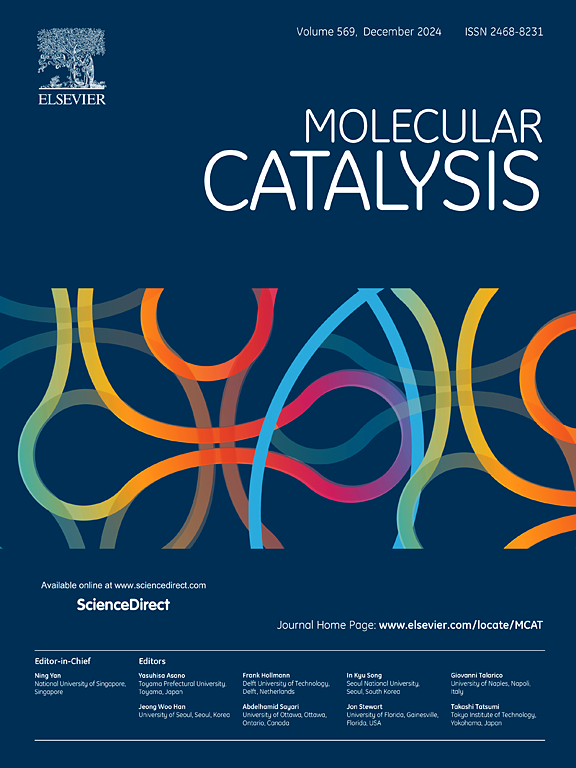Construction of electron-rich Co centers and abundant redox pairs in MnO2/CoMn2O4 heterointerfaces for PMS activation and water purification
IF 3.9
2区 化学
Q2 CHEMISTRY, PHYSICAL
引用次数: 0
Abstract
Multiphase catalysts with heterointerfaces have shown compelling potential in catalyzing oxidative mineralization of pollutants. In particular, the interfacial electron communication of heterointerfaces is beneficial for activation of reactant molecules through promotive interfacial electron transfer efficiency. In this study, a MnO2/CoMn2O4 heterojunction catalyst was constructed for the electron-rich Co centers and abundant redox pairs. Benefiting from the synergistic interaction between cobalt (Co2+/Co3+) and manganese (Mn2+/Mn3+/Mn4+) at the active sites, as well as the electron density difference between the interfaces of the two phases, a significant enhancement of the catalytic activity for peroxymonosulfate (PMS) activation was achieved. Systematic characterization analysis revealed that the catalyst has highly active catalytic sites characterized by electron-rich Co2+, and the electron-donating property of the high-electron-density Co2+ active sites in the A site of spinel CoMn2O4 promotes the efficient transfer of electrons and the rapid generation of reactive oxygen species (ROS) from PMS activation. More exposed catalytic active sites and significantly lower interfacial mass transfer resistance further enhanced the activation performance of the catalysts for bisphenol A degradation by these ROS. The optimal MnO2/CoMn2O4–5 exhibited a optimal BPA degradation activity (86 %, kobs = 0.316 min-1) and excellent resistance to anionic interference. The results of free radical quenching experiments indicated that single linear oxygen (1O2) and hydroxyl radical (·OH) were the main active substances for PMS activation and BPA degradation. This study provides meaningful insights into the improvement of heterojunction interfacial systems for catalytic efficiency enhancement and environmental remediation.

MnO2/CoMn2O4异质界面中富电子Co中心和丰富氧化还原对的构建及其在PMS活化和水净化中的应用
具有异质界面的多相催化剂在催化污染物氧化矿化方面显示出令人瞩目的潜力。特别是,异质界面的界面电子传递效率有利于活化反应物分子。本研究构建了一种 MnO2/CoMn2O4 异质结催化剂,其富含电子的 Co 中心和丰富的氧化还原对。得益于活性位点上钴(Co2+/Co3+)和锰(Mn2+/Mn3+/Mn4+)之间的协同作用以及两相界面之间的电子密度差,该催化剂显著提高了过一硫酸盐(PMS)活化的催化活性。系统表征分析表明,该催化剂具有以富含电子的 Co2+ 为特征的高活性催化位点,而尖晶石 CoMn2O4 A 位点上高电子密度 Co2+ 活性位点的电子捐献特性促进了电子的高效转移和 PMS 活化过程中活性氧(ROS)的快速生成。更多暴露的催化活性位点和显著降低的界面传质阻力进一步提高了催化剂在这些 ROS 作用下降解双酚 A 的活化性能。最佳的 MnO2/CoMn2O4-5 具有最佳的双酚 A 降解活性(86%,kobs = 0.316 min-1)和出色的抗阴离子干扰能力。自由基淬灭实验结果表明,单线态氧(1O2)和羟基自由基(-OH)是 PMS 活化和双酚 A 降解的主要活性物质。这项研究为改进异质结界面系统以提高催化效率和修复环境提供了有意义的见解。
本文章由计算机程序翻译,如有差异,请以英文原文为准。
求助全文
约1分钟内获得全文
求助全文
来源期刊

Molecular Catalysis
Chemical Engineering-Process Chemistry and Technology
CiteScore
6.90
自引率
10.90%
发文量
700
审稿时长
40 days
期刊介绍:
Molecular Catalysis publishes full papers that are original, rigorous, and scholarly contributions examining the molecular and atomic aspects of catalytic activation and reaction mechanisms. The fields covered are:
Heterogeneous catalysis including immobilized molecular catalysts
Homogeneous catalysis including organocatalysis, organometallic catalysis and biocatalysis
Photo- and electrochemistry
Theoretical aspects of catalysis analyzed by computational methods
 求助内容:
求助内容: 应助结果提醒方式:
应助结果提醒方式:


